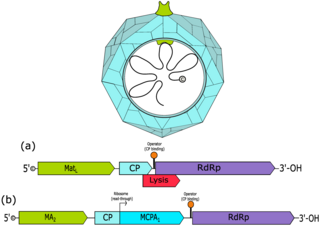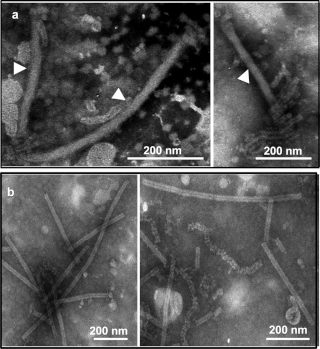| Jingchuvirales | |
|---|---|
| Virus classification | |
| (unranked): | Virus |
| Realm: | Riboviria |
| Kingdom: | Orthornavirae |
| Phylum: | Negarnaviricota |
| Class: | Monjiviricetes |
| Order: | Jingchuvirales |
| Jingchuvirales | |
|---|---|
| Virus classification | |
| (unranked): | Virus |
| Realm: | Riboviria |
| Kingdom: | Orthornavirae |
| Phylum: | Negarnaviricota |
| Class: | Monjiviricetes |
| Order: | Jingchuvirales |
The order contains the following families: [1]
Virus classification is the process of naming viruses and placing them into a taxonomic system similar to the classification systems used for cellular organisms.

Fiersviridae is a family of positive-strand RNA viruses which infect prokaryotes. Bacteria serve as the natural host. They are small viruses with linear, positive-sense, single-stranded RNA genomes that encode four proteins. All phages of this family require bacterial pili to attach to and infect cells. The family has 185 genera, most discovered by metagenomics. In 2020, the family was renamed from Leviviridae to its current name.

Marnaviridae is a family of positive-stranded RNA viruses in the order Picornavirales. The first species of this family that was isolated is Heterosigma akashiwo RNA virus (HaRNAV) in the genus Marnavirus, that infects the toxic bloom-forming Raphidophyte alga, Heterosigma akashiwo. Using a sequence-based framework an additional twenty marine RNA viruses have been added to the family.
Gammaflexiviridae is a family of viruses in the order Tymovirales. Fungi serve as natural hosts. There is only one genus in the family, Mycoflexivirus, which has one species: Botrytis virus F.

Mymonaviridae is a family of negative-strand RNA viruses in the order Mononegavirales, which infect fungi. Fungi serve as natural hosts. The name is a portmanteau of Ancient Greek myco, which means fungus, and mononegavirales. This family was established to accommodate Sclerotinia sclerotiorum negative-stranded RNA virus 1 (SsNSRV-1) a novel virus discovered in a hypovirulent strain of Sclerotinia sclerotiorum.
Tubulavirales is an order of viruses.
Mulpavirales is an order of viruses.
Halopanivirales is an order of viruses.
Tectiliviricetes is a class of viruses.
Durnavirales is an order of double-stranded RNA viruses which infect eukaryotes. The name of the group derives from Italian duplo which means double, rna for the type of virus, and -virales which is the suffix for a virus order.

Solemoviridae is a family of non-enveloped, positive-strand RNA viruses which infect plants. Solemoviridae is a member of the order Sobelivirales.

Adnaviria is a realm of viruses that includes archaeal viruses that have a filamentous virion and a linear, double-stranded DNA genome. The genome exists in A-form (A-DNA) and encodes a dimeric major capsid protein (MCP) that contains the SIRV2 fold, a type of alpha-helix bundle containing four helices. The virion consists of the genome encased in capsid proteins to form a helical nucleoprotein complex. For some viruses, this helix is surrounded by a lipid membrane called an envelope. Some contain an additional protein layer between the nucleoprotein helix and the envelope. Complete virions are long and thin and may be flexible or a stiff like a rod.
Naldaviricetes is a class of viruses, which infect arthropods. Members of Naldaviricetes are characterized by large enveloped rod-shaped virions, circular double-stranded DNA genomes, and replication in the nucleus of the host cell. All of them share a set of unique genes not found in other viruses, which include the presence of multiple interspersed direct repeats, various subunits of DNA polymerase and RNA polymerase, four late expression factor genes, and infectivity factor genes suggesting a common host entry mechanism.
Lefavirales is an order of viruses.
Leviviricetes is a class of viruses, which infect prokaryotes. Most of these bacteriophages were discovered by metagenomics.
Norzivirales is an order of viruses, which infect prokaryotes. Most of these bacteriophages were discovered by metagenomics.
Solspiviridae is a family of RNA viruses, which infect prokaryotes.
Blumeviridae is a family of RNA viruses, which infect prokaryotes.
Duinviridae is a family of RNA viruses, which infect prokaryotes.
Timlovirales is an order of viruses, which infect prokaryotes. Most of these bacteriophages were discovered by metagenomics.